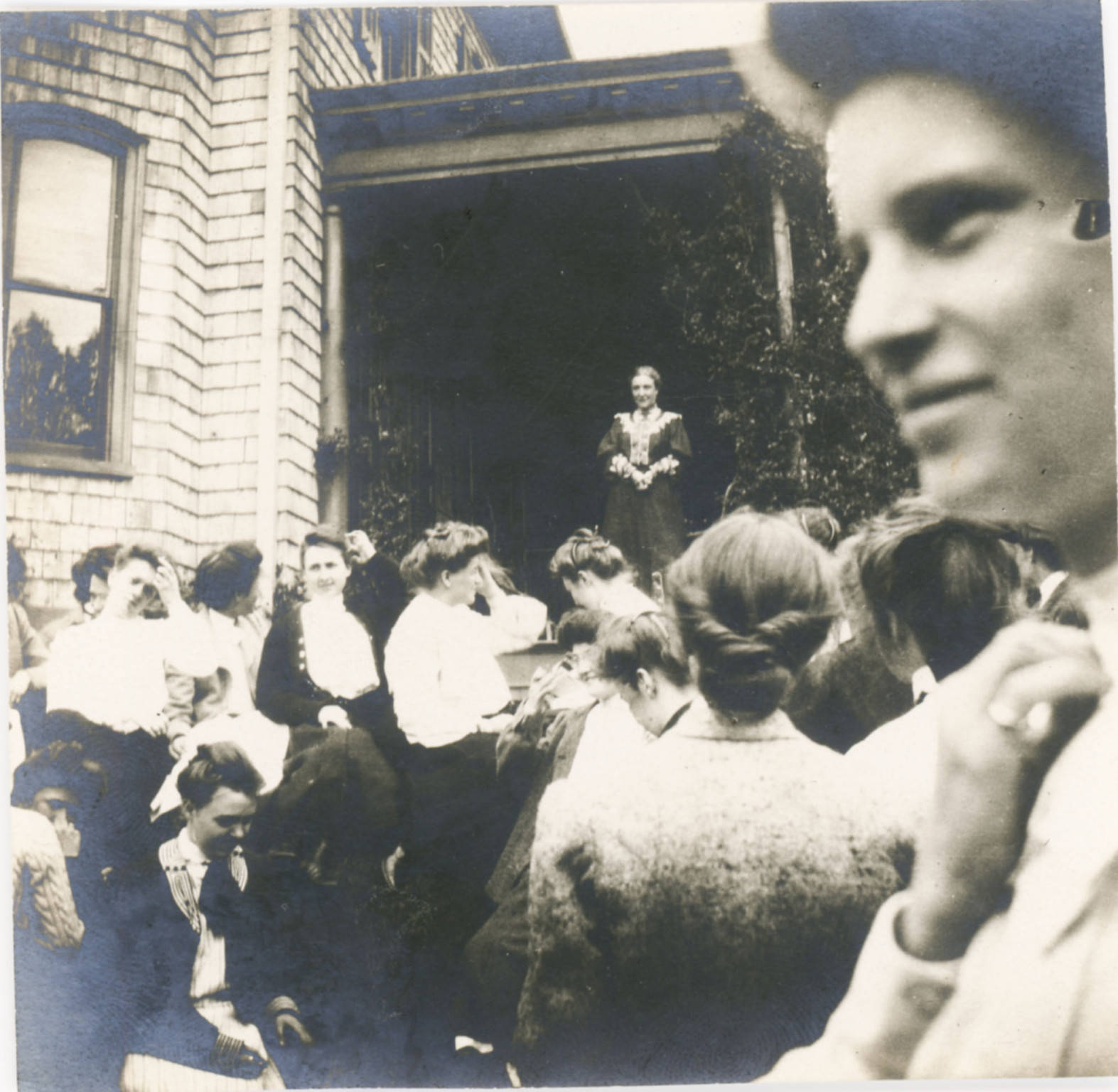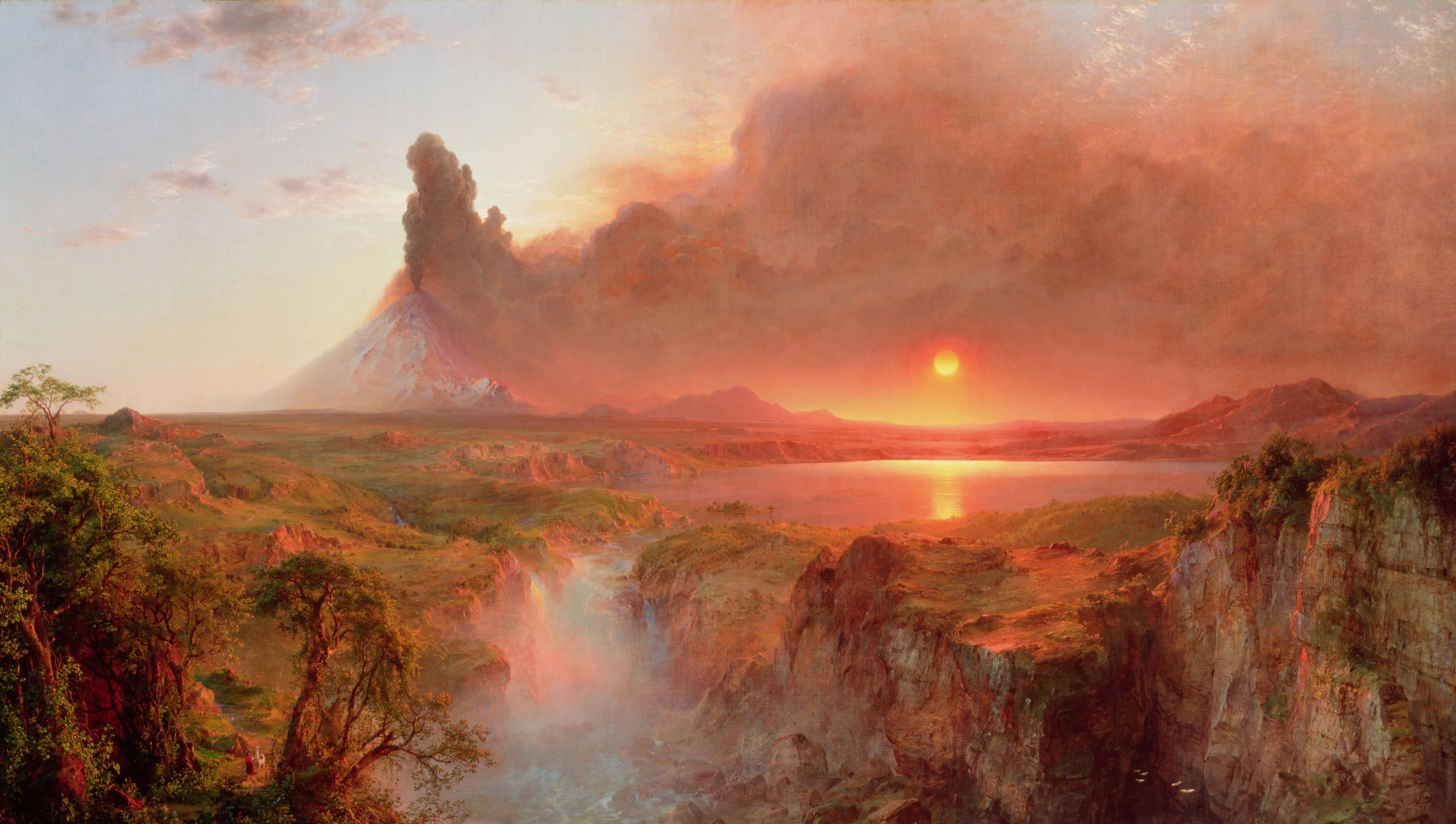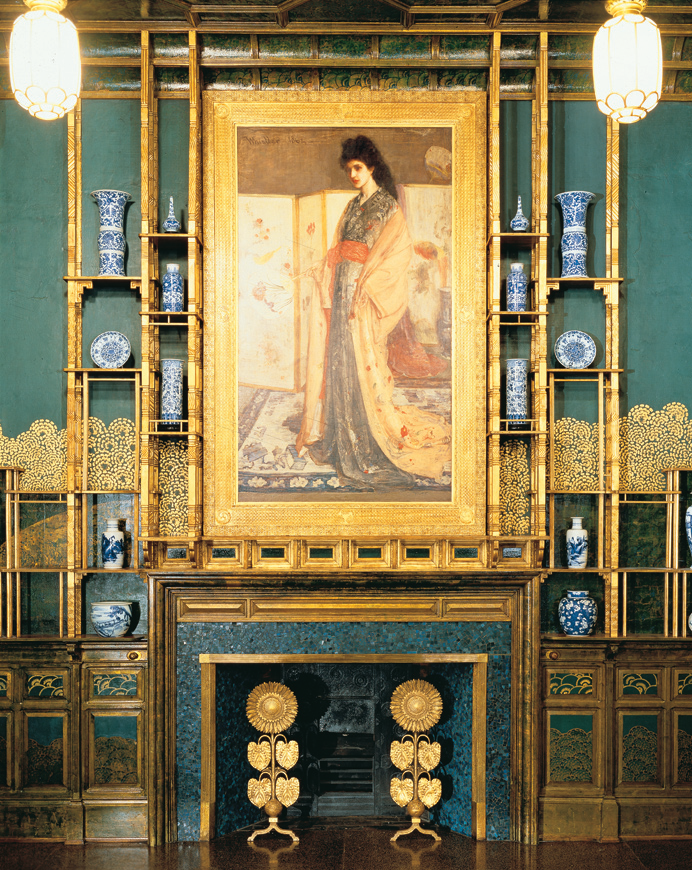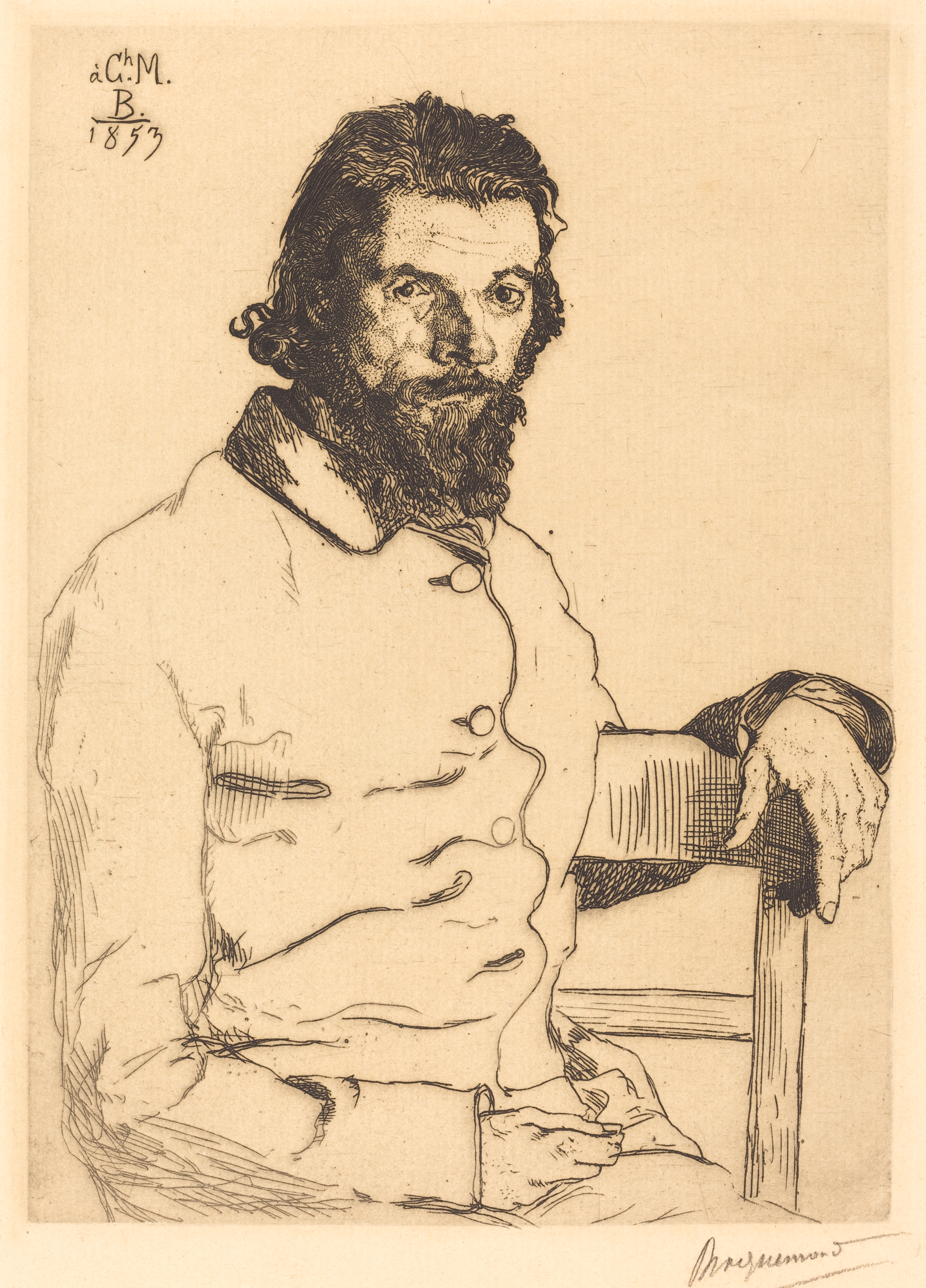|
Bryn Mawr College Deanery
The Bryn Mawr College Deanery was the campus residence of the first Dean and second President of Bryn Mawr College, Martha Carey Thomas, who maintained a home there from 1885 to 1933. Under the direction of Thomas, the Deanery was greatly enlarged and lavishly decorated for entertaining the college's important guests, students, and alumnae, as well as Thomas’ own immediate family and friends. From its origins as a modest five room Victorian cottage, the Deanery grew into a sprawling forty-six room mansion which included design features from several notable 19th and 20th century artists. The interior was elaborately decorated with the assistance of the American artist Lockwood de Forest and Louis Comfort Tiffany, de Forest's partner in the design firm Tiffany & de Forest, supplied a number of light fixtures of Tiffany glass. De Forest's design of the Deanery's so-called 'Blue Room' is particularly important as it is often considered one of the best American examples of an Aestheti ... [...More Info...] [...Related Items...] OR: [Wikipedia] [Google] [Baidu] |
Bryn Mawr College
Bryn Mawr College ( ; Welsh: ) is a women's liberal arts college in Bryn Mawr, Pennsylvania. Founded as a Quaker institution in 1885, Bryn Mawr is one of the Seven Sister colleges, a group of elite, historically women's colleges in the United States, and the Tri-College Consortium along with Haverford College and Swarthmore College. The college has an enrollment of about 1,350 undergraduate students and 450 graduate students. It was the first women's college to offer graduate education through a PhD. History Bryn Mawr College is a private women's liberal arts college founded in 1885. The phrase literally means 'large hill' in Welsh. The Graduate School is co-educational. It is named after the town of Bryn Mawr, in which the campus is located, which had been renamed by a representative of the Pennsylvania Railroad. Bryn Mawr was the name of an area estate granted to Rowland Ellis by William Penn in the 1680s. Ellis's former home, also called Bryn Mawr, was a house near Dolge ... [...More Info...] [...Related Items...] OR: [Wikipedia] [Google] [Baidu] |
Frederic Church
Frederic Edwin Church (May 4, 1826 – April 7, 1900) was an American landscape painter born in Hartford, Connecticut. He was a central figure in the Hudson River School of American landscape painters, best known for painting large landscapes, often depicting mountains, waterfalls, and sunsets. Church's paintings put an emphasis on realistic detail, dramatic light, and panoramic views. He debuted some of his major works in single-painting exhibitions to a paying and often enthralled audience in New York City. In his prime, he was one of the most famous painters in the United States. Biography Beginnings Frederic Edwin Church was a direct descendant of Richard Church, a Puritan pioneer from England who accompanied Thomas Hooker on the original journey through the wilderness from Massachusetts to what would become Hartford, Connecticut. Church was the son of Eliza (1796–1883) and Joseph Church (1793–1876). Frederic had two sisters and no surviving brothers. His father was ... [...More Info...] [...Related Items...] OR: [Wikipedia] [Google] [Baidu] |
Bertrand Russell
Bertrand Arthur William Russell, 3rd Earl Russell, (18 May 1872 – 2 February 1970) was a British mathematician, philosopher, logician, and public intellectual. He had a considerable influence on mathematics, logic, set theory, linguistics, artificial intelligence, cognitive science, computer science and various areas of analytic philosophy, especially philosophy of mathematics, philosophy of language, epistemology, and metaphysics.Stanford Encyclopedia of Philosophy"Bertrand Russell" 1 May 2003. He was one of the early 20th century's most prominent logicians, and a founder of analytic philosophy, along with his predecessor Gottlob Frege, his friend and colleague G. E. Moore and his student and protégé Ludwig Wittgenstein. Russell with Moore led the British "revolt against idealism". Together with his former teacher A. N. Whitehead, Russell wrote ''Principia Mathematica'', a milestone in the development of classical logic, and a major attempt to reduce the whole ... [...More Info...] [...Related Items...] OR: [Wikipedia] [Google] [Baidu] |
Eleonora Duse
Eleonora Giulia Amalia Duse ( , ; 3 October 185821 April 1924), often known simply as Duse, was an Italian actress, rated by many as the greatest of her time. She performed in many countries, notably in the plays of Gabriele d'Annunzio and Henrik Ibsen. Duse achieved a unique power of conviction and verity on the stage through intense absorption in the character, "eliminating the self" as she put it, and letting the qualities emerge from within, not imposed through artifice. Life and career Duse was born in Vigevano, Lombardy, in 1858 to Alessandro Vincenzo Duse (1820–1892) and Angelica Cappelletto (1833–1906). Both her father and her grandfather, Luigi, were actors from Chioggia, near Venice, and she joined the troupe at age four. Due to poverty, she initially worked continually, traveling from city to city with whichever troupe her family was currently engaged. She came to fame in Italian versions of roles made famous by Sarah Bernhardt, such as ''La Dame aux camélias'' ... [...More Info...] [...Related Items...] OR: [Wikipedia] [Google] [Baidu] |
Henry James
Henry James ( – ) was an American-British author. He is regarded as a key transitional figure between literary realism and literary modernism, and is considered by many to be among the greatest novelists in the English language. He was the son of Henry James Sr. and the brother of philosopher and psychologist William James and diarist Alice James. He is best known for his novels dealing with the social and marital interplay between ''émigré ''Americans, English people, and continental Europeans. Examples of such novels include '' The Portrait of a Lady'', ''The Ambassadors'', and ''The Wings of the Dove''. His later works were increasingly experimental. In describing the internal states of mind and social dynamics of his characters, James often wrote in a style in which ambiguous or contradictory motives and impressions were overlaid or juxtaposed in the discussion of a character's psyche. For their unique ambiguity, as well as for other aspects of their composition, his ... [...More Info...] [...Related Items...] OR: [Wikipedia] [Google] [Baidu] |
John Charles Olmsted
John Charles Olmsted (1852–1920), was an American landscape architect. The nephew and adopted son of Frederick Law Olmsted, he worked with his father and his younger brother, Frederick Law Olmsted, Jr., in their father's firm. After their father retired, the brothers took over leadership and founded Olmsted Brothers as a landscape design firm. The firm became well known for designing many urban parks, college campuses, and other public places. John Olmsted's body of work from over 40 years as a landscape architect has left its mark on the American urban landscape. Early life John Charles Olmsted was born in Geneva, Switzerland, in 1852 to John Olmsted and Mary Cleveland (Perkins) Olmsted. His father John, had contracted tuberculosis, which at the time had no treatment. Fresh air and healthy living, including exercise, were recommended. Some sanatoriums were established in mountain areas. The John Olmsted family returned to the United States to reside at Tosomock Farm on Stat ... [...More Info...] [...Related Items...] OR: [Wikipedia] [Google] [Baidu] |
Haddon Hall
Haddon Hall is an English country house on the River Wye near Bakewell, Derbyshire, a former seat of the Dukes of Rutland. It is the home of Lord Edward Manners (brother of the incumbent Duke) and his family. In form a medieval manor house, it has been described as "the most complete and most interesting house of tsperiod". The origins of the hall are from the 11th century, with additions at various stages between the 13th and the 17th centuries, latterly in the Tudor style. The Vernon family acquired the Manor of Haddon by a 12th-century marriage between Sir Richard de Vernon and Alice Avenell, daughter of William Avenell II. Four centuries later, in 1563, Dorothy Vernon, the daughter and heiress of Sir George Vernon, married John Manners, the second son of Thomas Manners, 1st Earl of Rutland. A legend grew up in the 19th century that Dorothy and Manners eloped. The legend has been made into novels, dramatisations and other works of fiction. She nevertheless inherited the ... [...More Info...] [...Related Items...] OR: [Wikipedia] [Google] [Baidu] |
Dorothy Vernon
Dorothy Vernon (1544 – 24 June 1584), the younger daughter of Sir George Vernon and Margaret ''nee'' Talbois (or Tailboys), was the heiress of Haddon Hall, an English country house in Derbyshire with its origins in the 12th century. She married John Manners in 1563.Dare, p. 25 The couple's descendants, the Dukes of Rutland, continue to own Haddon Hall. A legend grew up in the 19th century that Vernon and Manners eloped, and a number of novels, dramatisations and other works of fiction have been based on the legend. Family background and legend Sir George Vernon was a prosperous and hospitable landowner in Derbyshire, and his family seat was at Haddon Hall, which is England's best preserved medieval manor house and a major tourist attraction. His second daughter, Dorothy, fell in love with John Manners (c. 1534 – 4 June 1611), the second son of Thomas Manners, the first Earl of Rutland.Trutt (2006), p. 7 According to historian Paul Dare's 1924 book, ''Ayleston Manor and C ... [...More Info...] [...Related Items...] OR: [Wikipedia] [Google] [Baidu] |
Lockwood De Forest Swing In Deanery
Lockwood may refer to: Places Australia *Lockwood, Victoria *Lockwood South, Victoria United Kingdom * Lockwood, North Yorkshire, England *Lockwood, West Yorkshire, England United States *Lockwood, Amador County, California *Lockwood, Monterey County, California *Lockwood, Michigan, an unincorporated community in Ovid Township, Branch County, Michigan *Lockwood, Missouri *Lockwood, Montana *Lockwood, Nebraska *Lockwood, New York, an unincorporated hamlet in the town of Barton, New York. *Lockwood, West Virginia Greenland *Lockwood Island Other uses *Lockwood (surname), a list of people and fictional characters *'' Lockwood & Co.'', book series **'' Lockwood & Co.'' (TV series), TV series adaptation *Lockwood (company), lock brand in Australia *Lockwood Aircraft, an American ultralight aircraft manufacturer *Lockwood Broadcast Group, an American broadcasting company *''Lockwood v. American Airlines, Inc. ''Lockwood v. American Airlines, Inc.'', 107 F.3d 1565 (Fed. Cir. 1997), w ... [...More Info...] [...Related Items...] OR: [Wikipedia] [Google] [Baidu] |
The Peacock Room
''Harmony in Blue and Gold: The Peacock Room'' (better known as ''The Peacock Room'') is a masterpiece of interior decorative art created by James McNeill Whistler and Thomas Jeckyll, translocated to the Freer Gallery of Art in Washington, DC. Whistler painted the paneled room in a rich and unified palette of brilliant blue-greens with over- glazing and metallic gold leaf. Painted between 1876–77, it now is considered one of the greatest surviving Aesthetic interiors, and best examples of the Anglo-Japanese style. History ''The Peacock Room'' was originally designed as a dining room in the townhouse located at in the neighbourhood of Kensington in London, and owned by the British shipping magnate Frederick Richards Leyland. Leyland engaged the British architect Richard Norman Shaw to remodel and redecorate his home. Shaw entrusted the remodelling of the dining room to Thomas Jeckyll, another British architect experienced in the Anglo-Japanese style. Jeckyll conceived the dini ... [...More Info...] [...Related Items...] OR: [Wikipedia] [Google] [Baidu] |
Charles Méryon
Charles Meryon (sometimes Méryon, 23 November 1821 – 14 February 1868) was a French artist who worked almost entirely in etching, as he had colour blindness. Although now little-known in the English-speaking world, he is generally recognised as the most significant etcher of 19th century France. His most famous works are a series of views powerfully conveying his distinctive Gothic vision of Paris. He also had mental illness, dying in an asylum. Meryon's mother was a dancer at the Paris Opera, who moved to London around 1814 to dance there. In 1818 she had a daughter by Viscount Lowther, the future William Lowther, 2nd Earl of Lonsdale, a wealthy aristocrat and politician, and 1821 Charles Meryon by Dr Charles Lewis Meryon, an English doctor, returning to Paris for the birth, and remaining there for the rest of her life. The household in Paris was supported financially by both fathers, but more so by Lowther, whose indirect funding remained important throughout Meryon's ... [...More Info...] [...Related Items...] OR: [Wikipedia] [Google] [Baidu] |









